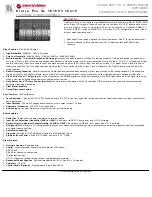
Redundancy
12.2
Media Redundancy Protocol (MRP)
152
UM Config GRS
Release
8.0
09/2019
12.2.2
Reconfiguration time
When a line section fails, the Ring Manager changes the MRP-Ring back into a line structure. You
define the maximum time for the reconfiguration of the line in the Ring Manager.
Possible values for the maximum delay time:
•
500 ms
•
200 ms
Note:
If every device in the ring supports the shorter delay time, then you can configure the
reconfiguration time with a value less than 500 ms.
Otherwise the devices that only support longer delay times might not be reachable due to
overloading. Loops can occur as a result.
12.2.3
Advanced mode
For times even shorter than the specified reconfiguration times, the device provides the advanced
mode. When the ring participants inform the Ring Manager of interruptions in the ring via link-down
notifications, the advanced mode speeds up the link failure recognition.
Hirschmann devices support link-down notifications. Therefore, you generally activate the
advanced mode in the Ring Manager.
When you are using devices that do not support link-down notifications, the Ring Manager
reconfigures the line in the selected maximum reconfiguration time.
12.2.4
Prerequisites for MRP
Before setting up an MRP-Ring, verify that the following conditions are fulfilled:
All ring participants support MRP.
The ring participants are connected to each other via the ring ports. Apart from the device’s
neighbors, no other ring participants are connected to the respective device.
All ring participants support the configuration time specified in the Ring Manager.
There is exactly 1 Ring Manager in the ring.
If you are using VLANs, then configure every ring port with the following settings:
Deactivate ingress filtering - see the
Switching > VLAN > Port
dialog.
Define the port VLAN ID (PVID) - see the
Switching > VLAN > Port
dialog.
–
PVID =
1
in cases where the device transmits the MRP data packets untagged (VLAN ID =
0
in
Switching > L2-Redundancy > MRP
dialog)
By setting the PVID =
1
, the device automatically assigns the received untagged packets to
VLAN 1.
–
PVID =
any
in cases where the device transmits the MRP data packets in a VLAN (VLAN ID
≥
1
in the
Switching > L2-Redundancy > MRP
dialog)
Define egress rules - see
Switching > VLAN > Configuration
dialog.
–
U
(untagged) for the ring ports of VLAN 1 in cases where the device transmits the MRP data
packets untagged (VLAN ID =
0
in the
Switching > L2-Redundancy > MRP
dialog, the MRP ring
is not assigned to a VLAN).
–
T
(tagged) for the ring ports of the VLAN which you assign to the MRP ring. Select
T
, in cases
where the device transmits the MRP data packets in a VLAN (VLAN ID ≥
1
in the
Switching >
L2-Redundancy
> MRP
dialog).
Summary of Contents for GREYHOUND GRS1020
Page 8: ......
Page 16: ......
Page 146: ......
Page 232: ......
Page 310: ......
Page 330: ......
Page 338: ...Readers Comments 337 RM GUI GRS Release 8 0 09 2019 ...
Page 339: ......
Page 340: ......
Page 350: ......
Page 354: ......
Page 617: ...Readers Comments 277 UM Config GRS Release 8 0 09 2019 ...
Page 618: ......
Page 619: ......
















































